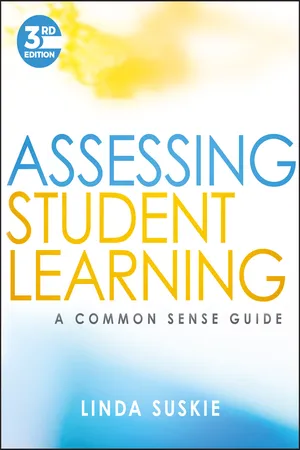
- English
- ePUB (mobile friendly)
- Available on iOS & Android
About this book
Assessing Student Learning is a standard reference for college faculty and administrators, and the third edition of this highly regarded book continues to offer comprehensive, practical, plainspoken guidance. The third edition adds a stronger emphasis on making assessment useful; greater attention to building a culture in which assessment is used to inform important decisions; an enhanced focus on the many settings of assessment, especially general education and co-curricula; a new emphasis on synthesizing evidence of student learning into an overall picture of an integrated learning experience;new chapters on curriculum design and assessing the hard-to-assess; more thorough information on organizing assessment processes; new frameworks for rubric design and setting standards and targets; and many new resources. Faculty, administrators, new and experienced assessment practitioners, and students in graduate courses on higher education assessment will all find this a valuable addition to their bookshelves.
Frequently asked questions
- Essential is ideal for learners and professionals who enjoy exploring a wide range of subjects. Access the Essential Library with 800,000+ trusted titles and best-sellers across business, personal growth, and the humanities. Includes unlimited reading time and Standard Read Aloud voice.
- Complete: Perfect for advanced learners and researchers needing full, unrestricted access. Unlock 1.4M+ books across hundreds of subjects, including academic and specialized titles. The Complete Plan also includes advanced features like Premium Read Aloud and Research Assistant.
Please note we cannot support devices running on iOS 13 and Android 7 or earlier. Learn more about using the app.
Information
Part 1
Understanding Assessment
CHAPTER 1
What Is Assessment?
Some valuable ideas you'll find in this chapter
- Assessment is simply deciding what we want students to learn and making sure they learn it.
- Assessment is a cousin of traditional empirical research.
- Assessment today is based on research on effective teaching strategies in higher education.
Jargon Alert!
- We have evidence of how well our students are achieving our key learning goals.
- The quality of that evidence is good enough that we can use it to inform important decisions, especially regarding helping students learn.
- We use that evidence not only to assess the achievement of individual students but also to reflect on what we are doing and, if warranted, change what we're doing.
Assessment is part of teaching and learning

List 1.1 The Four-Step Teaching-Learning-Assessment Process
- Establish clear, observable expected goals for student learning
- Ensure that students have sufficient opportunities to achieve those goals
- Systematically gather, analyze, and interpret evidence of how well student learning meets those goals
- Use the resulting information to understand and improve student learning
Jargon Alert!
Comparing traditional and current approaches to assessment
| Traditional Approaches: Assessment is. . . | Contemporary Approaches: Assessment is. . . |
| Planned and implemented without consideration of learning goals, if any even exist | Carefully aligned with learning goals: The most important things we want students to learn (Chapter 4) |
| Often focused on memorized knowledge | Focused on thinking and performance skills (Chapter 4) |
| Often poor quality, simply because faculty and staff have had few formal opportunities to learn how to design and use effective assessment strategies and tools | Developed from research and best practices on teaching and assessment methodologies (Chapters 3 and 26) |
| Used only to assess and grade individual students, with decisions about changes to curricula and pedagogies often based on hunches and anecdotes rather than solid evidence | Used to improve teaching, learning, and student success as well as to assign grades and otherwise assess individual students (Chapters 6 and 26) |
| Used only in individual course sections; not connected to anything else | Viewed as part of an integrated, collaborative learning experience (Chapter 2) |
| Not used to tell the story ... |
Table of contents
- Cover
- Title Page
- Table of Contents
- List of Tables
- List of Lists
- List of Figure
- List of Exhibits
- Preface to the Third Edition
- Introduction
- Part 1: Understanding Assessment
- Part 2: Laying a Foundation for Assessment Success
- Part 3: Building a Pervasive, Enduring Culture of Evidence and Betterment
- Part 4: The Assessment Toolbox
- Part 5: Understanding and Using Evidence of Student Learning
- References
- Index
- End User License Agreement